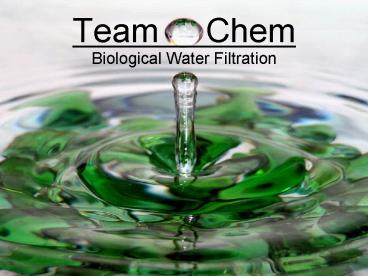Team Chem - PowerPoint PPT Presentation
Title: Team Chem
1
Team Chem
- Biological Water Filtration
2
Purification Process
- Add plants to possibly contaminated water
- Plant cells take in arsenic and store it
- Cells provide an output (color/light) signaling
the water is clean or needs further processing - Separate plants from water
- Possibility for further processing
3
Operating System
4
Operating System
5
Devices
- 2 Arsenic Sensors
- activated by any arsenic (2.5 ppb)
- activated by maximum tolerable arsenic level
- 2 Light Generators
- Arsenic Transport and Storage Device
6
Arsenic Transport and Storage
Arsenic Measurement
Remove the gene that encodes this transport
protein
Tripathi, R.D., Srivastava, S., Mishra, S.,
Singh, N., Tuli, R., Gupta, D.K. and Maathuis, F.
Arsenic Hazards Strategies for Tolerance and
Remediation by Plants. Trends in Biotechnology.
2007, 25.4, 158-165.
7
Device Level Diagram
Blue Light Generator
Red Light Generator
8
Simulation Pure Water
Blue Light Generator
Red Light Generator
Result No Light ? Separation
9
Simulation Maximum Arsenic
Blue Light Generator
Red Light Generator
Result Cells Emit Red Light ? Separate and
Process Again
10
Timing Diagram Maximum Arsenic
Blue Light Generator
2.5 ppb As Sensor
Transport and Storage
Maximum As Sensor
Red Light Generator
Contaminated Water Added
Midlevel As
Maximum As
11
Timing Diagram Midlevel Arsenic
Blue Light Generator
2.5 ppb As Sensor
Transport and Storage
Maximum As Sensor
Red Light Generator
Contaminated Water Added
Midlevel As
Maximum As
12
Biological PartsBackground System
ARR2
ARR1
Arsenic resistance genes reduce arsenic so it can
be complexed to the storage protein
13
Biological Parts Genetic Circuit
P(Y)
Constitutively active
AtPCS1
AtABBC1
AtABBC2
Arsenic Transport
P(X)
P(ArsR)
BLGD BBa_K325909
2.5 ppb Arsenic
P(ArsD)
RLGD BBa_K325219
Maximum Arsenic
Y-Repressor
X-Repressor
Constitutively active
ArsR BBa_J33201
ArsD Max Arsenic
Arsenic Detectors
2.5 ppb
Arsenic
14
Biological Parts Genetic Circuit
Result Blue Light
Result Red Light
Arsenic
15
Parts List
Gene Description Genes BioBrick Number
Resistance ARR1, ARR2 BBa_M34575
Transport and Storage AtABCC1, AtABCC2, AtPSC1 BBa_M34576
Detection ArsR BBa_J33201
Light Generation BLGD RLGD BBa_K325909 BBa_K325219
16
Cellular Chassis
Sourcehttp//www.botany.hawaii.edu/nlc_biology/1
406/lab/r2/slide6.jpg
Source http//www.ppws.vt.edu/scott/weed_id/eldd
e.htm
17
Nucleus vs. Chloroplasts
- Chloroplasts
- Genes cannot be passed on by pollination
- Very difficult to control how genes are passed to
new generations - Nucleus
- Cross-pollination would be a major issue
- Crops that take in and store arsenic
- Solution
- Elodea can be asexual
- Easy to implant genes a plant can grow from a
few cells - No threat of cross-breeding
18
Testing/Debugging
- Cell Death
- Effectiveness of Transport
- and Storage of Arsenic
- Need to determine vacuole limits - maximum
tolerable arsenic concentration - Testing Light Generators
- Promoter Design
- ArsR works for concentrations 2.5 ppb
- ArsD must be tuned to experimentally determined
maximum arsenic concentration
Source http//www.sciencephoto.com/images/
19
Global Impacts
20
Impacts
- If this process succeeds
- Solves one of the most problematic issues of the
developing world, saving millions of lives. - 70 million people are affected in Bangladesh
alone - arsenic in ground water is the cause of
23 of all the deaths there!
21
Kanchan Arsenic Filter
- 35 per filter
- 90 efficient (brings down to 50 ppb if there
was 500 initially). - Returns back to the ground at the end.
22
Why Biological Water Filtration by Team Chemistry?
- No energy requirement (operates independent of
electricity) - Accessibility to effective water filtration
technology even in rural parts of the developing
world - Very low cost of sustaining system
- The end product is not a waste
- Plants could be sent to central processing center
when full. Arsenic could be removed and used for
chemotherapy. - More efficient than any other existing arsenic
filters.
23
Open Issues
- The cost of entire project is unknown.
- Legal issues attached to introducing genetically
modified organisms into the environment? - Length of effectiveness is unknown
- (How long until the organism reaches max arsenic
uptake capacity?) - The rate of arsenic uptake is unknown.
- The process of genetically modifying plants is
very slow.
24
Citations
- Bobrowicz, P et al. Isolation of three
contiguous genes, ACR1, ACR2 and ACR3, involved
in resistance to arsenic compounds in the yeast
Saccharomyces cerevisiae. Yeast (Chichester,
England) 13.9 (1997) 819-28. lthttp//www.ncbi.nlm
.nih.gov/pubmed/9234670gt. - Deepesh N. De.Plant cell vacuoles an
introduction. CSIRO Publishing, Collingwood,
2000. - Dhingra, Amit, and Henry Daniell. Chloroplast
genetic engineering via organogenesis or somatic
embryogenesis. Methods in molecular biology
(Clifton, N.J.) 323.6 (2006) 245-62.
http//www.ncbi.nlm.nih.gov/pubmed/16892222. - Song, W.-Y. et al. Arsenic tolerance in
Arabidopsis is mediated by two ABCC-type
phytochelatin transporters. Proceedings of the
National Academy of Sciences 18 (2010). 17 Nov.
2010 lthttp//www.pnas.org/cgi/doi/10.1073/pnas.101
3964107gt. - Tripathi, Rudra D et al. Arsenic hazards
strategies for tolerance and remediation by
plants. Trends in biotechnology 25.4 (2007)
158-65. 9 Jul. 2010 lthttp//www.ncbi.nlm.nih.gov/p
ubmed/17306392gt.
25
Citations
Kanchan Water Filter http//web.mit.edu/watsan/te
ch_hwts_chemical_kanchanarsenicfilter.html State
of Washington, Department of Ecology
http//www.ecy.wa.gov/programs/wq/plants/weeds/aqu
a002.html Registry of Standard Biological Parts
http//partsregistry.org/Main_Page National
Center for Biotechnology Information
http//www.ncbi.nlm.nih.gov/ Sacchromyces Genome
Databasewww.yeastgenome.org The Oligator (to
remove unwanted restriction sites)
http//gcat.davidson.edu/igem10/index.html Transl
ation Map (Sequence Manipulation Suite- to make
sure mutations didnt change the proteins)
http//biosyn.avxtrk.net/Gizmo/Tools/SMS/trans_map
.html
26
Acknowledgements
Dr. June Medford, Department of Biology, Colorado
State University Susan Murcott, Department of
Civil and Environmental Engineering, MIT Dr.
Chris French, Institute of Structural and
Molecular Biology, School of Biological Sciences,
University of Edinburgh Dr. Natalie
Kuldell 20.385 Mentors Yuan, Tina, Andrew and
Pei.































